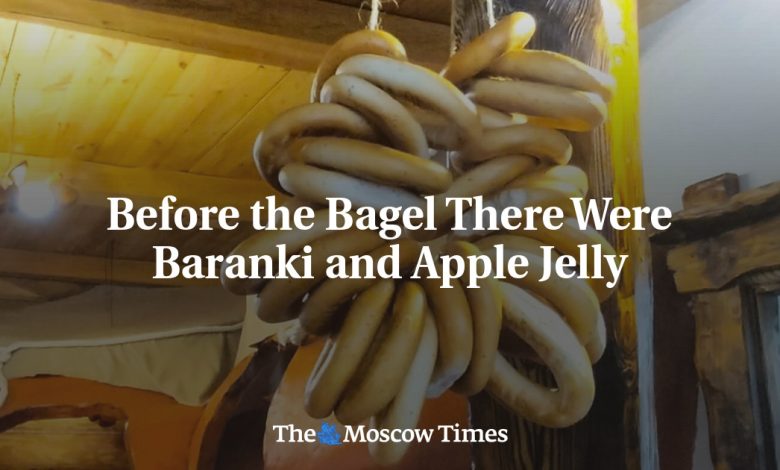Before the Bagel There Were Baranki and Apple Jelly

As soon as our compatriots hear the word “baranka” — a hard round bread roll — they immediately begin to hum the famous song “Golden Domed Moscow” where “candy and baranki are like swan sleighs…”
It’s good that Putin’s patriots don’t know the awful truth: this anthem of the old Russia we lost is set to the tune of “Mayn yidishe meydle” (“My Jewish Girl”). The song was actually written in 1922 by the American composer Sholom Secunda with lyrics by Anschel Schorr.
So even baranki (plural of baranka) is a dangerous topic in modern Russia. But all the same, we’ll muster our courage and continue our tale of these traditional hard round rolls.
Baranki is a name that just about everyone knows. But it has its own secrets. Baranki were not mentioned in written sources until the beginning of the 17th century. The chronicle of the Iversky Monastery informs us that in 1665 “the brethren bought boranki and eggs for ten altyn.”
In other words, baranki aren’t as old and traditional as many think. Baranki are mentioned for the first time in official documents in a decree of Peter the Great in 1725 when they already had a fixed price since they weighed more than the weight of flour used because they were moist. Preparing baranki by first scalding them boiling water before baking appeared in our country in the second half of the 18th century and became widespread in the 19th century.
The homeland of baranki was in the western Russian provinces and Poland. They appeared on the Russian table en masse when Russia expanded to these places. Although baranki are traditionally associated with Valdai, which is considered the historical production center of baranki, in reality everything was more complicated, and there is probably no specific city where they were “invented.”
It seems that this culinary folk tradition appeared in those places (in Belarus, which was part of Poland, and in the Western Novgorod region) quite a long time ago — back in the 16th and 17th centuries. They appeared when there was a sharp uptake in grain production, which let the local residents “experiment” with bread products. In essence baranki were a kind of “canned bread” that could be stored for a long time. But gradually the baranki took on a more elegant role and became something of a delicacy.
Many sources testify to the “baranka” tradition. For example, in a note of the Archbishop of Mogilev in 1794 he wrote that “baranki are a kind of bread made here.” Even earlier Vasily Severgin in his book “Notes on a Journey through the Western Provinces of the Russian State” (1803) wrote: “There is little white bread in Grodno, but instead they bake fine white bread [made of thin wheat flour]. There are also Polish obarzanki, similar to Valdai baranki.”
As we see, even in the late 18th century Valdai and Polish baranki were stable images, clearly associated with the western regions of Russia and Poland. Therefore, the version of the famous culinary expert William Pokhlebkin that baranki were invented in the Belarus city of Smorhon came from only one source: He read somewhere that in the 17th century they fed tame bears baranki on the Radziwill estate located there. A curious fact, but nothing more than a random historical note.
As for the term “Moscow baranki” — for most of us this comes from the work by Ilf and Petrov, “Twelve Chairs,” where Soviet crooks created the Odesa bublik and baranka artel. Seriously, of course baranki were made in Moscow before the Revolution, but there wasn’t a special Moscow variety.
The “Guide for Confectioners and Bakers” written in 1912 will help us to understand the difference between baranki and bagels: “Baranki are made of dough that is a mixture of flour and water. The dough is kneaded very hard and for a long time. Bagels, on the other hand, are made from yeast-based dough, they are kneaded simply, quickly cut, and then boiled and baked.”
Baranki had their shining hour in Russia in the beginning of 20th century when there was a particularly large assortment of breads. In 1910-1914, the main varieties were: French bun (65%), trifle (1%), temse bread sold by weight (12%), Moscow kalachi (10%), baranki (8%).
Baranki were not forgotten in Soviet times either. In 1966 the Moscow Experimental Factory of Baranki products was opened in the Butyrsky district of Moscow. But the bread and baranki business shared the fate of socialism in our country, and by the end of the 1980s it was in decline.
What do you eat baranki with? Of course, with tea. And with all sorts of sweets. For example, with this apple jelly, which we reproduced from a recipe from a cookbook published in Moscow in 1829.





